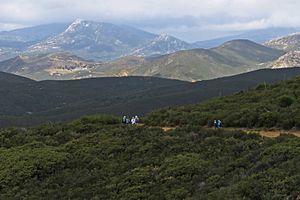Cuyamaca, California

Cuyamaca (Kumeyaay: ‘Ekwiiyemak)[1] is a region of eastern San Diego County. It lies east of the Capitan Grande Indian Reservation in the western Laguna Mountains, north of Descanso and south of Julian. Named for the 1845 Rancho Cuyamaca Mexican land grant, the region is now dominated by the 26,000-acre (110 km2) Cuyamaca Rancho State Park. Within the park is the prominent Cuyamaca Peak, the second-highest mountain in San Diego County at 6,512 feet (1,984.9 m).
The name is a Spanish corruption of the Kumeyaay phrase "'Ekwiiyemak", which means, according to Margaret Langdon's translation, "Behind the clouds".[2] It has also been translated as "the place where it rains", a reference to the region's higher average precipitation than San Diego County's low coastal areas. Cuyamaca is a popular toponym lending its name to streets, businesses and a community college in the San Diego area.
History
During the Julian Gold Rush, a quartz gold mine; the Stonewall Mine, was found on the south side of what is now Lake Cuyamaca. First a mining camp called Stonewall (1873–1876), then the mining company town of Stratton (1887–1888), renamed Cuyamaca City (1888–1906),[3] at its peak had a population of 500 and served the Stonewall Mine.
In 1906, the post office was closed and service moved to Descanso. The town was abandoned after mining operations ceased, and few traces of it exist.[4] The site of the town now lies within Cuyamaca Rancho State Park[5] at 32°59′05″N 116°34′15″W / 32.98472°N 116.57083°W.
The modern community of Cuyamaca later developed on the north side of the lake. Before the Cedar Fire of 2003, the community of Cuyamaca consisted of approximately 145 homes on a mountain (North Peak) north of the reservoir.
Cedar Fire
In October 2003, most of the Cuyamaca region was consumed by the Cedar Fire. Nearly 25,000 acres (100 km2) in the state park and 120 homes in the community of Cuyamaca were incinerated. The historic Dyer Ranch house in the center of the state park, which functioned as a museum and the park headquarters, was also destroyed.[6]
Climate
| Climate data for Cuyamaca, CA (1991-2020 normals) | |||||||||||||
|---|---|---|---|---|---|---|---|---|---|---|---|---|---|
| Month | Jan | Feb | Mar | Apr | May | Jun | Jul | Aug | Sep | Oct | Nov | Dec | Year |
| Average high °F (°C) | 51.1 (10.6) |
51.2 (10.7) |
55.2 (12.9) |
59.5 (15.3) |
66.6 (19.2) |
76.0 (24.4) |
83.2 (28.4) |
84.1 (28.9) |
79.1 (26.2) |
68.6 (20.3) |
58.7 (14.8) |
50.8 (10.4) |
65.4 (18.6) |
| Daily mean °F (°C) | 42.0 (5.6) |
42.4 (5.8) |
45.7 (7.6) |
49.1 (9.5) |
55.3 (12.9) |
63.6 (17.6) |
70.7 (21.5) |
70.8 (21.6) |
65.1 (18.4) |
55.2 (12.9) |
47.0 (8.3) |
41.3 (5.2) |
54.0 (12.2) |
| Average low °F (°C) | 33.0 (0.6) |
33.5 (0.8) |
36.2 (2.3) |
38.7 (3.7) |
43.9 (6.6) |
51.2 (10.7) |
58.1 (14.5) |
57.6 (14.2) |
51.2 (10.7) |
41.8 (5.4) |
35.3 (1.8) |
31.8 (−0.1) |
42.7 (5.9) |
| Average precipitation inches (mm) | 5.51 (140) |
6.43 (163) |
4.87 (124) |
2.34 (59) |
1.06 (27) |
0.17 (4.3) |
0.35 (8.9) |
0.50 (13) |
0.57 (14) |
1.46 (37) |
2.65 (67) |
4.34 (110) |
30.25 (768) |
| Average snowfall inches (cm) | 3.8 (9.7) |
5.4 (14) |
5.5 (14) |
3.1 (7.9) |
0.1 (0.25) |
0.0 (0.0) |
0.0 (0.0) |
0.0 (0.0) |
0.0 (0.0) |
0.0 (0.0) |
0.7 (1.8) |
1.3 (3.3) |
19.9 (51) |
| Average precipitation days (≥ 0.01 in) | 7.2 | 7.9 | 7.2 | 5.3 | 3.2 | 0.9 | 1.7 | 1.9 | 1.7 | 3.5 | 4.4 | 7.3 | 52.2 |
| Average snowy days (≥ 0.1 in) | 1.4 | 2.4 | 1.6 | 1.0 | 0.1 | 0.0 | 0.0 | 0.0 | 0.0 | 0.0 | 0.4 | 1.1 | 8.0 |
| Source: NOAA[7][8] | |||||||||||||
References
- ^ Ted Couro and Christina Hutcheson (1973), Dictionary of Mesa Grande Diegueño, Malki Museum Press, Morongo Indian Reservation, Banning, California
- ^ Erwin G. Gudde (author) and William Bright (Revised by) (1998) [1949], California Place Names: The Origin and Etymology of Current Geographical Names (4 ed.), University of California Press
{{citation}}:|author=has generic name (help). - ^ Frickstad, Walter N., A Century of California Post Offices 1848-1954, Philatelic Research Society, Oakland, CA. 1955, pp. 147–158
- ^ Pourade, Richard, The History of San Diego, Chapter 4, The Mountain that Sprouted Gold
- ^ Sampson, Michael, Recent Archaeological Investigations at the Stonewall Mine Site
- ^ "California wildfires burn through 600,000 acres", CNN, October 29, 2003, retrieved August 30, 2007 Archived October 30, 2003, at the Wayback Machine
- ^ "NOWData - NOAA Online Weather Data". National Oceanic and Atmospheric Administration.
{{cite web}}: Missing or empty|url=(help) - ^ "Monthly Normals 1991-2020". National Oceanic and Atmospheric Administration. Retrieved March 21, 2022.
External links
Coordinates: 32°56′46″N 116°34′34″W / 32.94611°N 116.57611°W
- CS1 errors: generic name
- Webarchive template wayback links
- CS1 errors: requires URL
- Coordinates not on Wikidata
- AC with 0 elements
- Geography of San Diego County, California
- East County (San Diego County)
- Ghost towns in California
- History of San Diego
- Kumeyaay
- Former settlements in San Diego County, California
- Populated places established in 1887


